

![]() I have a thing that lies on my bookshelf collecting dust. That thing is a hunk of glass. And so, you might ask, why would anyone have a hunk of glass lying on his bookshelf?
I have a thing that lies on my bookshelf collecting dust. That thing is a hunk of glass. And so, you might ask, why would anyone have a hunk of glass lying on his bookshelf?
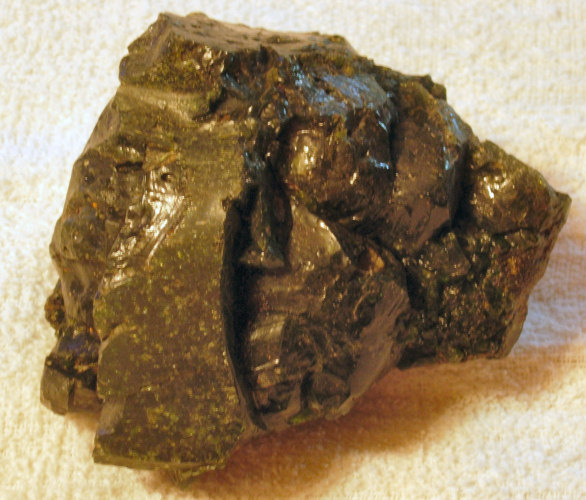
![]() The hunk of glass started out as a hunk of iron ore stuck in some rocks along with a bunch of other stuff. At some time in the 1830s or 40s, that hunk of iron ore (stuck in some rocks along with a bunch of other stuff), was wrenched from its home, probably by a Irish immigrant using a pickax, and dumped, like so many other hunks of iron ore, into the open top of a furnace.
The hunk of glass started out as a hunk of iron ore stuck in some rocks along with a bunch of other stuff. At some time in the 1830s or 40s, that hunk of iron ore (stuck in some rocks along with a bunch of other stuff), was wrenched from its home, probably by a Irish immigrant using a pickax, and dumped, like so many other hunks of iron ore, into the open top of a furnace.
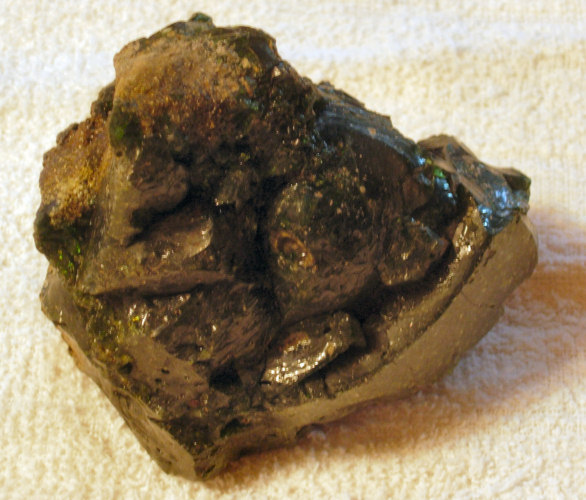
![]() You see, the hunk of glass is actually the refuse of the ironmaking industry that thrived in this south-central region of Pennsylvania in the 1800s.
You see, the hunk of glass is actually the refuse of the ironmaking industry that thrived in this south-central region of Pennsylvania in the 1800s.
![]() Starting in the year 1828, Peter Shoenberger, a wealthy ironmaster from Pittsburgh, began to build a series of iron furnaces and forges throughout this region. He named them after his daughters, including: Sarah, Martha, Maria and Rebecca. Shoenberger also bought up large tracts of land in the region in order to obtain the iron ore, limestone and wood that would be needed to operate the furnaces.
Starting in the year 1828, Peter Shoenberger, a wealthy ironmaster from Pittsburgh, began to build a series of iron furnaces and forges throughout this region. He named them after his daughters, including: Sarah, Martha, Maria and Rebecca. Shoenberger also bought up large tracts of land in the region in order to obtain the iron ore, limestone and wood that would be needed to operate the furnaces.
![]() The ironmaking process was not really all that complicated. Iron ore would be dug out of the ground, and then dumped into the open top of the iron furnace by workers (mostly Irish immigrants fleeing from their homeland because of the potato famines) using wheelbarrows, or by carts drawn by mules. The purpose of filling the furnace with the iron ore would be to heat it until the metal melted out of the rock to which it was attached. Wood was cut into standard lengths and then stacked in the form of a truncated cone by a collier, a man who burned the stack slowly in order for it to turn into charcoal, which would then be used to fire the furnace. Limestone was quarried out of the ground and then heated in its own small furnace before being stacked in piles in an open field, where it would be rained upon and allowed to slake, or crumble, into limestone dust. Then it would be dumped into the furnace to help cause the various 'impurities' to separate from the iron as it melted. The furnace would be located alongside a river so that the energy of the moving water could be harnessed to turn machinery gears that operated large bellows to pump air into the furnace when necessary.
The ironmaking process was not really all that complicated. Iron ore would be dug out of the ground, and then dumped into the open top of the iron furnace by workers (mostly Irish immigrants fleeing from their homeland because of the potato famines) using wheelbarrows, or by carts drawn by mules. The purpose of filling the furnace with the iron ore would be to heat it until the metal melted out of the rock to which it was attached. Wood was cut into standard lengths and then stacked in the form of a truncated cone by a collier, a man who burned the stack slowly in order for it to turn into charcoal, which would then be used to fire the furnace. Limestone was quarried out of the ground and then heated in its own small furnace before being stacked in piles in an open field, where it would be rained upon and allowed to slake, or crumble, into limestone dust. Then it would be dumped into the furnace to help cause the various 'impurities' to separate from the iron as it melted. The furnace would be located alongside a river so that the energy of the moving water could be harnessed to turn machinery gears that operated large bellows to pump air into the furnace when necessary.
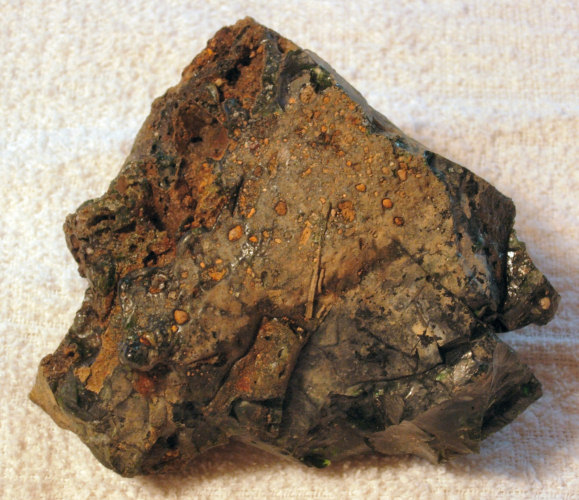
![]() As the iron ore melted and separated from the impurities in the rock, small access holes near the bottom of the furnace would be unplugged and knocked open. This allowed the molten iron metal to flow out of the furnace and into a main trench and numerous offshoots dug into the ground. As the outside air hit the hot metal emerging from the furnace, the furnace was said to "blast" with an explosion of sound that could be heard for up to ten miles around. (Many people called the iron furnace a blast furnace for that reason.) The molten iron, leaving the furnace and pouring into the trenches and their offshoots, formed what was called the sow and pigs ~ hence the name pigiron for the initial product drawn from the furnace. After the pigiron was pounded, heated and pounded again many times in an adjacent iron forge, it was given the name of wrought iron.
As the iron ore melted and separated from the impurities in the rock, small access holes near the bottom of the furnace would be unplugged and knocked open. This allowed the molten iron metal to flow out of the furnace and into a main trench and numerous offshoots dug into the ground. As the outside air hit the hot metal emerging from the furnace, the furnace was said to "blast" with an explosion of sound that could be heard for up to ten miles around. (Many people called the iron furnace a blast furnace for that reason.) The molten iron, leaving the furnace and pouring into the trenches and their offshoots, formed what was called the sow and pigs ~ hence the name pigiron for the initial product drawn from the furnace. After the pigiron was pounded, heated and pounded again many times in an adjacent iron forge, it was given the name of wrought iron.
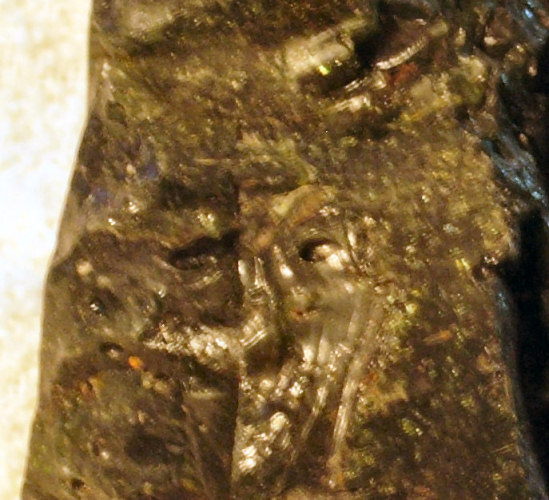
![]() So we now come to the thing that lies on my bookshelf collecting dust. It is a piece of glass, like I previously stated, but it is not glass that was intended to be glass. Instead, it is a piece of glass that formed in the iron furnace (the Sarah Furnace near the town of Claysburg to be exact) when the limestone dust caused sand and other impurities to separate from the iron. Commonly called slag, the stuff that comprised the impurities would sometimes fuse together into, among other refuse, glass. After the molten iron would be completely drained from the furnace, the remaining mass of impurities would be raked out of the furnace, and transported to a dump heap by those same Irish workers using either wheelbarrows or mule-drawn carts.
So we now come to the thing that lies on my bookshelf collecting dust. It is a piece of glass, like I previously stated, but it is not glass that was intended to be glass. Instead, it is a piece of glass that formed in the iron furnace (the Sarah Furnace near the town of Claysburg to be exact) when the limestone dust caused sand and other impurities to separate from the iron. Commonly called slag, the stuff that comprised the impurities would sometimes fuse together into, among other refuse, glass. After the molten iron would be completely drained from the furnace, the remaining mass of impurities would be raked out of the furnace, and transported to a dump heap by those same Irish workers using either wheelbarrows or mule-drawn carts.
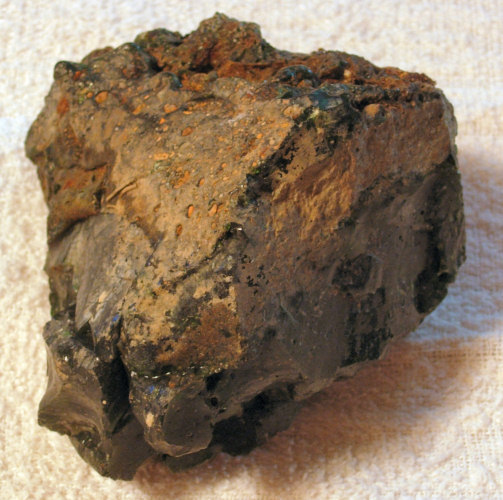
![]() The thing that lies on my bookshelf collecting dust lay on that dump heap for 150 years before being retrieved by a friend of mine while out for a walk, who in turn gave it to me (when I saw it on her desk at work, and exclaimed "Wow! That's a beautiful piece of slag!").
The thing that lies on my bookshelf collecting dust lay on that dump heap for 150 years before being retrieved by a friend of mine while out for a walk, who in turn gave it to me (when I saw it on her desk at work, and exclaimed "Wow! That's a beautiful piece of slag!").
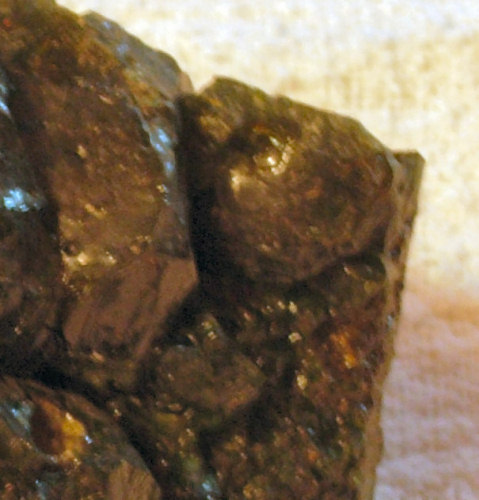
![]() What might not be seen in the photos of this piece of slag is the intensely beautiful green color. And what can't be experienced by this blog's readers is the razor sharp edges ~ it is real glass!
What might not be seen in the photos of this piece of slag is the intensely beautiful green color. And what can't be experienced by this blog's readers is the razor sharp edges ~ it is real glass!
